Endophytic fungi live inside various tissues and organs of healthy plants, and infected plants do not show obvious external disease. Endophytic fungi can act as carriers of exogenous genes that can promote plant growth, resistance to adversity and disease, and increase the allelopathy and resistance of host plants to pathogenic bacteria. The endophytic nature of endophytic fungi can be demonstrated by histological methods, isolation from plant tissues, or direct amplification of fungal DNA from within plant tissues. The isolation and identification of endophytic fungi are the basis of strain research and application.
Lifeasible provides a one-stop service for the isolation, identification, and active substance testing of plant endophytic fungi and is committed to providing customers with comprehensive and accurate information about plant endophytic fungi.
 Figure 1. The shape characteristics of the hypha. (Tang Z, et al., 2020)
Figure 1. The shape characteristics of the hypha. (Tang Z, et al., 2020)
| Antioxidant activity assay | DPPH free radical scavenging method |
| ABTS+ free radical scavenging method | |
| Anti-tumor activity assay | Cancer cell proliferation assay |
| Immunomodulatory activity assay | In vitro lymphocyte proliferation assay |
| Antidiabetic activity assay | α-glucosidase inhibition assay |
| α-amylase inhibition assay |
Lifeasible can help customers analyze the diversity and biological activity of plant endophytic fungi to support their further research. As your trusted partner, we can meet your needs for endophytic fungal identification and isolation services and provide you with efficient and high-quality services. If you want to know the details, please contact us.
Reference
Lifeasible has established a one-stop service platform for plants. In addition to obtaining customized solutions for plant genetic engineering, customers can also conduct follow-up analysis and research on plants through our analysis platform. The analytical services we provide include but are not limited to the following:
STU-CRISPR System Improves Plant Genome Editing Efficiency
April 19, 2024
Application of Exosomes in Facial Beauty
April 12, 2024